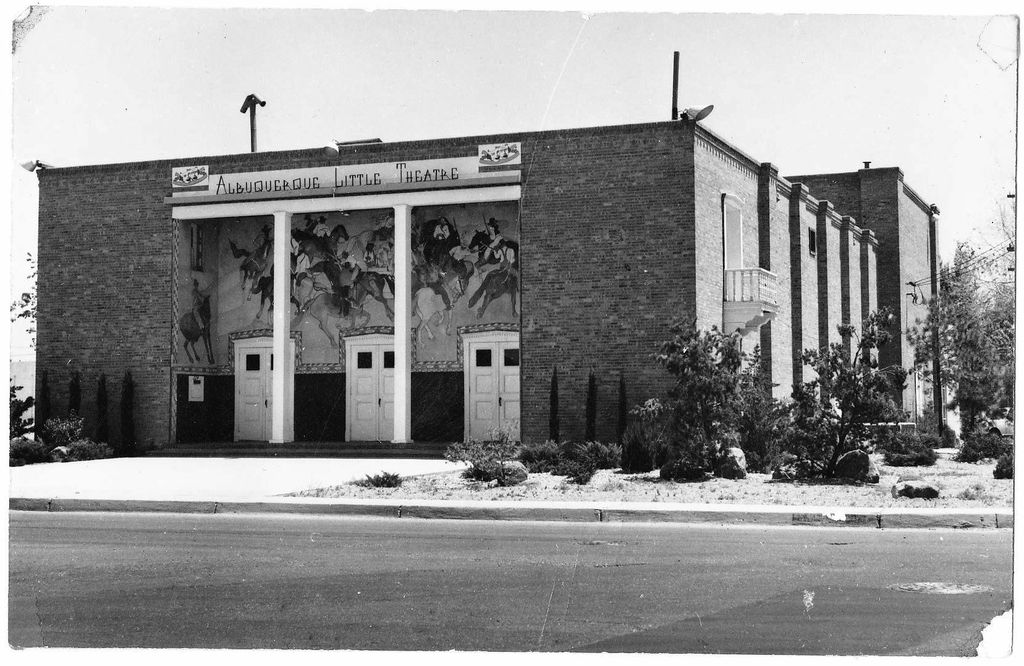The Albuquerque Little Theatre was founded in 1930 by a group of civicminded citizens led by Irene Fisher, a reporter and the society editor for the New Mexico Tribune. The concept of a local theater group was created when Fisher attended a lecture by Kathryn Kennedy O’Connor, a professional actress who moved to New Mexico in 1927 for health reasons. Fisher organized and led the campaign to raise money for an operating budget of $1,000, and O’Connor was hired as the theater’s director. The Albuquerque Little Theatre spent its first six years at the KiMo Theatre in downtown Albuquerque. As early as 1916, little theaters had been starting up all over the United States. New York had become too expensive for many people, and second- and third-rate road companies started offering the theater experience to the masses. The phrase “little theater” is not precisely accurate. It should be called the community theater. The name “little” became attached to any theater that was not fully commercial by the 1920s.
During Mrs. Kennedy O’Connor’s lecture at the University of New Mexico, she mentioned the theater, which caught the attention of a reporter named Ms. Fisher, who wrote editorials in the local newspaper that stressed the need for a theater in Albuquerque. This raised awareness, and soon, the community began raising funds. The first production was a play called Rain, starring Mrs.
O’Connor and directed by her husband. All of the productions were done at the KiMo in hopes of raising enough money to build their own local theater, one that would only perform plays and not show moving pictures. Mr. Clinton Anderson, a U.S. senator, said there were only two good things in Albuquerque: the salubrious climate and the Little Theatre. He soon became the president of the Little Theatre Board of Directors.
Mr. Herbenstriet donated a lot to build the Little Theatre, located off Central Avenue and near Old Town. The original building was designed by famed southwestern architect John Gaw Meem and was the first structure in Albuquerque to be built by the Works Progress Administration as part of President Franklin Roosevelt’s New Deal in 1936.
Building the Little Theatre was extremely difficult. Anyone who sits in the building today knows of the day-to-day struggle and tension of locating and paying for the mortar, tin, cement and other materials used in its construction. Indeed, everybody now takes the building for granted, and some think that it is not quite nice enough. The theater’s seats were purchased by putting on a New Year’s Eve party. Costing two dollars apiece, the seats are still in use today. When finally completed, the auditorium floor was made of concrete and slopes rather sharply for some ten rows and then flattens out the remaining distance to the orchestra pit, instead of having a gradual incline from the lobby doors down to the stage. The concrete presented a problem when it came to fastening down the seats. With the help of some National Youth Administration boys, James O’Connor drilled two thousand holes in the concrete in which they secured the theater seats he had purchased from the Sunshine (motion picture) Theater. Some of the actors also helped with this arduous task.
In the beginning, there were no dressing rooms. For some time, the actors and crew used an old workmen’s shanty left after the building was completed and an old boxcar that James O’Connor brought from the railroad for restroom and dressing room facilities. The boxcar had been purchased for $50 and eventually burned down. However, the insurance money and funds from Mrs. Simms in the amount of $4,000 paid off all debts, and a dressing room and workshop were built. The city relinquished its authority under the basis that the building would be used for “educational purposes.” The government also granted the theater freedom from taxation. In 1930, on the opening of the Little Theatre’s first play, This Thing Called Love, the society editors of both the Journal and the Tribune wrote magnanimously of their impressions of the audience and the show.
O’Connor retired as the theater’s director in 1961, and the board named Bernard Thomas to succeed her as the Albuquerque Little Theatre’s fulltime director. Thomas served as the theater’s director from 1961 to 1980 and starred in many of its productions, including Teahouse of the August Moon and His and Hers. He was married to Reba Thomas, who hosted a daily matinée movie on a local Albuquerque television channel. Bernard also appeared in the motion picture Roughneck. During Thomas’s years as director, he brought many popular comedies and a fine assortment
of dramas. He exposed Albuquerque audiences to some unusual fare, including the world premiere of David Madden’s Cassandra Singing. Thomas retired in 1980 after the fiftieth anniversary season. He was replaced by his technical director, Michael Myers, who served as producing director until 1986, when Sandy Brady replaced him, and Carol Fleming was named general manager in 1988. She stayed with Little Theatre until 1996.
In March 1997, Larry D. Parker was named the Albuquerque Little Theatre’s new executive director and continued producing quality theater through the 2005–6 season. The current executive director is Henry Avery. He took that role in the spring of 2008.
